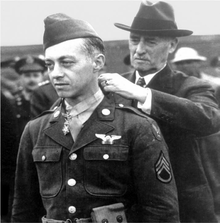Maynard Harrison Smith
| Staff Sergeant Maynard Harrison Smith United States Army Air Corps | |
|---|---|

Sec.of War Henry L. Stimson awards MOH to S/Sgt. Smith
|
|
| Nickname(s) | Snuffy Smith |
| Born |
May 19, 1911 Caro, Michigan |
| Died | May 11, 1984 (aged 72) |
| Allegiance |
|
| Service/branch | United States Army Air Corps |
| Years of service | 1942–1945 |
| Rank | Staff Sergeant |
| Unit | 423d Bombardment Squadron |
| Battles/wars | World War II |
| Awards |
Medal of Honor Air Medal |
Maynard Harrison "Snuffy" Smith (May 19, 1911 - May 11, 1984), US Army Air Forces Staff Sergeant and gunner aboard a B-17 Flying Fortress bomber in World War II, received the Medal of Honor for his conduct during a bombing mission over France on May 1, 1943.
Maynard H. Smith enlisted in the US Army Air Forces in 1942. After completing basic training he volunteered for aerial gunnery school. At the time all aerial gunners were non-commissioned officers and the move to the school was a quick way for the private to gain rank and pay.
After completing the aerial gunnery school, he was shipped overseas to Thurleigh, Bedfordshire, in south-central England, where he joined the 423rd Bombardment Squadron, 306th Bomb Group. Staff Sergeant Smith quickly gained a reputation as a stubborn and obnoxious airman who did not get along well with the other airmen stationed there, hence his nickname "Snuffy Smith", possibly from the popular comic strip of the era, Barney Google and Snuffy Smith. Consequently, it was six weeks before he was assigned his first combat mission.
It was during his first mission, on May 1, 1943 that Staff Sergeant Smith, who was assigned to the ball gun turret, helped save the lives of six of his wounded comrades, put out a blazing fire, and drove off wave after wave of German fighters.
The target of the mission was the U-Boat pens at Saint-Nazaire in Loire-Atlantique, France, on the Bay of Biscay. Saint Nazaire was heavily defended by antiaircraft guns and was nicknamed "flak city" by the airmen.
Several of the bombers failed to rendezvous as intended, and others had mechanical problems and had to turn back. The middle portion of the bombing mission went well, with no German fighters engaging the mission until after they had released their bomb loads. The bombers managed to drop their payload on target with little resistance from the Germans in occupied France. As the fighters came up, the bombing group managed to elude them by flying into a large cloud bank.
...
Wikipedia
